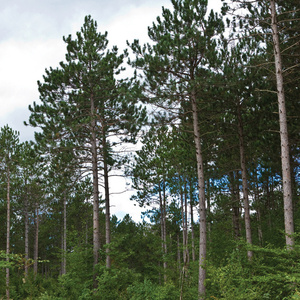Researchers propose method to estimate forest biomass cover




November 1, 2012
BY Erin Krueger
A research paper published in the open access journal Carbon Balance and Management employs satellite data to create a method to generate sample-based inventory of forest biomass. The study uses light detection and ranging (LIDAR) height data collected by the Geosciences Laser Altimeter System.
In the paper, the authors propose a method of identifying a subset of the data that can be treated as a random sample in a model-based biomass estimation. Using the method, the team created an estimate of biomass within the state of California. The resulting estimate was within the 1.4 percent standard error of estimate supplied by the U.S. National Forestry Inventory.
According to the analysis, LIDAR instruments measure the characteristics of laser pulses as they return from objects at different heights. One benefit of the method is that the laser pulses generally are able to penetrate deeper into the forest canopy than the signals used by optical sensors, which have also been used to estimate forest biomass. Another benefit pointed out by the paper is reduced cost. Excluding the cost of the satellite that collected the data, the cost of the estimate was almost nothing. In comparison, the authors point out that the NFI estimate cost at least $10.5 million to complete.
In the paper, the team describes the importance of developing more effective ways to measure forest biomass. Global initiatives, such as the United Nations Collaborative Programmed on Reducing Emissions from Deforestation and Degradation in Developing Countries, depend on accurate, precise and consistent reports of forest carbon storage on a country by country level. One problem with relying on national forest inventories, such as the ones completed in the U.S., is that not all countries complete them, and the ones that do often differ in methods and definitions. Satellite-based monitoring, however, may offer a method to generate more consistent estimations.
Advertisement
Advertisement
The paper, titled “A sample design for globally consistent biomass estimation using lidar data from the Geoscience Laser Altimer System,” was published Oct. 31. The team includes researchers from The U.S. Forest Service, the NASA Jet Propulsion Laboratory and Colorado State University.
Advertisement
Advertisement
Related Stories
The U.S. Department of Energy Bioenergy Technologies Office (BETO) announced up to $23 million in funding to support research and development (R&D) of domestic chemicals and fuels from biomass and waste resources.
The U.S. DOE has announced its intent to issue funding to support high-impact research and development (R&D) projects in two priority areas: sustainable propane and renewable chemicals and algal system cultivation and preprocessing.
Sens. Sherrod Brown, D-Ohio, and Pete Ricketts, R-Neb., in August introduced the Renewable Chemicals Act, a bill that aims to create a tax credit to support the production of biobased chemicals.
The Chemical Catalysis for Bioenergy Consortium, a consortium of the U.S. DOE’s Bioenergy Technologies Office, has launched an effort that aims to gather community input on the development of new biomass processing facilities.
USDA on March 8 celebrated the second annual National Biobased Products Day, a celebration to raise public awareness of biobased products, their benefits and their contributions to the U.S. economy and rural communities.
Upcoming Events










